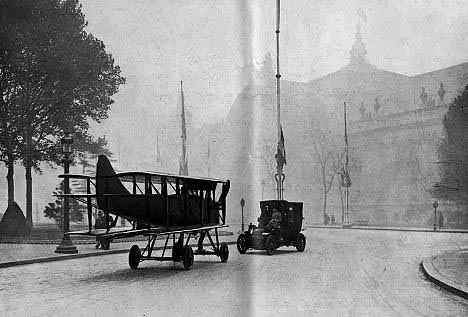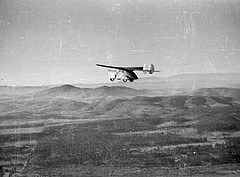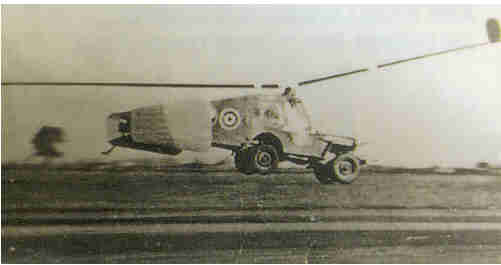World's Largest Flying Car Archive (Part 1 of 3)
- Story Cars

- Nov 11, 2021
- 12 min read
Updated: Nov 4, 2024
A flying car or roadable aircraft is a type of vehicle that can function as both a personal car and an aircraft. The term "flying car" is also sometimes used to include hovercars.
Many prototypes have been built since the early 20th century, using a variety of flight technologies. Although VTOL projects are increasing, most have been designed to take off and land conventionally using a runway. None has yet been built in more than a handful of numbers.
Flying cars are also a popular theme in fantasy and science fiction stories. Futurologists often predict their appearance, and many concept designs have been promoted. But their failure to become a practical reality has led to the catchphrase "Where's my flying car?" as a paradigm for the failure of predicted technologies to appear. For the sake of this article, Story Cars will cover the flying concepts, projects, and prototypes of the 20th and 21st centuries.
Part 1 of 3 includes every pre-1950 flying car known to the internet and eBooks. Comment below if any are missing from the archive.
Part 1
1917 Curtiss Autoplane
1921 Tampier Autoplane
1925 Skroback Roadable Airplane
1935 Autogiro Company of America AC-35
1935 Waterman Arrowbile
1935 Vlachos Triphibian
1939 Southernaire Roadable Flying Car
1940 Jess Dixon’s Flying Automobile
1942 Hafner Rotabuggy
1944 Airmaster Autoplane Flying Car
1945 Norman Bel Geddes Flying Car Model
1946 Fulton Airphibian Autoplane
1946 Convair Flying Car
1946 Aerauto PL.5C Autoplane
1949 Aerocar I N4994P
Part 2
Part 3
1917 Curtiss Autoplane
The Curtiss Autoplane, invented by Glenn Curtiss in 1917, is widely considered the first attempt to build a roadable aircraft. Although the vehicle was capable of lifting off the ground, it never achieved full flight. The Autoplane was a triplane, using the wings from a Curtiss Model L trainer, with a small foreplane mounted on the aircraft's nose. The Autoplane's aluminum body resembled a Model T and had three seats in an enclosed cabin, with the pilot/chauffeur sitting in the front seat and the two passengers side-by-side to the rear. It used a four-blade pusher propeller and a twin-boom tail. A 100 horsepower (75 kW) Curtiss OXX engine drove the propeller via shaft and belts. The aircraft had a four-wheel undercarriage, with the front two wheels being steerable. The wings and tail could be detached for use as an automobile. It was shown at the Pan-American Aeronautic Exposition in New York City in February 1917. It made a few short hops before the entry of the United States into World War I in April 1917 ended the development of the Autoplane.
1921 Tampier Autoplane
In France, René Tampier unveiled an airplane-motor car prototype that impressed the crowds. While driving on the road, imagine the field of vision as the aircraft's tail obstructed it! To prepare the flying machine for road use, the pilot had to turn to face the other direction and fold down the wings. This prototype was the only unit ever built, and it ended up in a museum following reliability issues.
1925 Skroback Roadable Airplane

The Skroback Roadable Airplane was an early attempt to produce a roadable airplane. To keep the aircraft within a reasonable width for driving with fixed wings, the inventor used many wing surfaces along the length of the vehicle. Frank E. Skroback was an inventor with several patents. His concept of a roadable started with sketches in 1927. The vehicle was inspired by the French designs of Henri Mignet and his Flying Flea. The prototype was completed in 1934.
The finished prototype used three pairs of short seven-foot span biplane wings positioned at the vehicle's front, middle, and rear. A small set of rudders on the rear wing assembly could be operated differentially to provide yaw and roll in flight. The vehicle was powered by a tractor configuration Continental A-40 engine driving a propeller. The "body" or fuselage, used spruce stringers, was fabric covered and resembled a dirigible shape. The wheels were positioned in the conventional taildragger configuration.
Initial tests in 1945 proved the vehicle lacked rudder authority on the ground. It was placed in storage, and then work commenced again in 1957. The vehicle was road driven in Syracuse, New York, and Maine. The Willowbrook Village Museum in Newfield, Maine, had the vehicle in its collection but later considered it out of the museum's scope. It was offered by auction in Atlanta, Georgia, in 2010, with a sale price of $66,175.
1935 Autogiro Company of America AC-35
The Autogiro Company of America AC-35 was an early attempt to make a roadable aircraft in the United States during the 1930s. Although it was successfully tested, it did not enter production; a 1960s attempt to revive the aircraft in a non-roadable version failed to succeed.
The aircraft design process started in 1935. The Experimental Development Section of the Bureau of Air Commerce contracted a roadable aircraft based around a PA-22 autogyro from ACA's parent company, Pitcairn Autogiro Company. The vehicle could fly at high speed in the air and drive up to 25 mph (40 km/h) on the ground with its rotors stowed. Six other companies were contracted to produce a roadable aircraft, but the AC-35 was the only one that met all the requirements.
The AC-35 had side-by-side seating with a small baggage compartment. The fuselage was a steel tube in front and wood construction in the tail with fabric covering overall. The engine was rear-mounted with a shaft-driven forward propeller. The vehicle had three equal size wheels (two in front, one in the rear). The rear wheel was shaft driven from the engine, and the front wheels provided steering.
On March 26, 1936, the AC-35 was flown by test pilot James G. Ray with counter-rotating propellers. These were later replaced with a single conventional propeller arrangement. On October 2, 1936, Ray landed the AC-35 in a downtown park in Washington, D.C., where it was displayed. On October 26, 1936, the aircraft was converted to a roadable configuration. Ray drove it to the main entrance of the Commerce Building, where it was accepted by John H. Geisse, chief of the Aeronautics Branch. It was driven to Bolling Field for additional testing and review by Hap Arnold. The Autogiro Company of America tested the aircraft at Pitcairn Field until 1942. In 1950 the Bureau of Air Commerce transferred the AC-35 to the Smithsonian Institution.
1935 Waterman Arrowbile
The Waterman Arrowbile was a tailless, two-seat, single-engine, pusher configuration roadable aircraft built in the US in the late 1930s. One of the first of its kind, it flew safely but generated little customer interest, and only five were produced.
Waldo Waterman's first flying wing aircraft was the unofficially named Waterman Whatsit, a pusher configuration low swept-wing monoplane with fins near its wingtips. The Whatsit also featured a wing-mounted tricycle undercarriage and a trim foreplane. Powered by a 100 hp (75 kW) Kinner K-5 5-cylinder radial pusher engine, it first flew in 1932.

In May 1935, Waterman completed a submission to the government-funded Vidal Safety Airplane competition. This was the Arrowplane, sometimes known as the W-4. This adopted a similar layout to the Whatsit but had a strut-braced high wing on a blunt-nosed, narrow fuselage pod with a tricycle undercarriage mounted under it. Its wings had wooden spars and metal ribs and were fabric-covered, with triangular endplate fins carrying upright rudders. Its fuselage was steel framed and aluminum covered. It was powered by a 95 hp (71 kW) inverted inline 4-cylinder Menasco B-4 Pirate pusher engine mounted high in the rear of the fuselage.
The Arrowplane was not intended for production or to be readable. Still, its success in the Vidal competition encouraged Waterman to form the Waterman Arrowplane Co. in 1935 to produce a roadable version. The resulting Arrowbile, referred to by Waterman as the W-5, was similar structurally and aerodynamically to the Arrowplane. However, the fins differed in shape, with rounded leading edges and swept-back rudder hinges. For road use, the wings and propeller could be quickly detached.
The main other differences were:
Engine choice.
The need to drive the wheels.
Using conventional car floor-type controls on the road.
The air-cooled Menasco was replaced by a water-cooled engine as used by most cars. Waterman modified a 6-cylinder upright, 100 hp (75 kW) Studebaker unit and placed it lower down in the pod, driving the propeller shaft at the top of the fuselage via six ganged V-belts with a 1.94:1 speed reduction. The radiator was in the forward fuselage, fed from a duct opening in the extreme upper nose. The engine drove the main wheels through a differential gear on the ground, as normal, and the car was steered by its nosewheel. The wheels were enclosed in fairings, initially as a road safety measure. Instead of removing the propeller for the road, it could be de-clutched to prevent windmilling the engine at speed.

The wheel in the two-seat cabin controlled the Arrowbile both on the road and in the air. Outer wing elevons moved together to alter pitch and differentially to bank. The rudders, interconnected with the elevons when the wheel was turned, moved only outwards, so the inner rudder was used in turn, adjusting yaw as normal and assisting the elevon in depressing the inner wingtip. This system had been used on the Arrowplane as a safety feature to avoid the commonly fatal spin out of the climb and turn from take-off accident. Still, the raked rudder hinge of the Arrowbile provided the banking component even from a nose-down attitude. There were no conventional flaps or wing-mounted airbrakes, but the rudders could be operated as brakes by opening them outwards together with a control independent of the wheel. The cabin interior was designed to motor car standards, with easy access and a baggage space under the seats. The Arrowbile first flew on 21 February 1937, making it a close contemporary of the Gwinn Aircar.
1935 Vlachos Triphibian
In 1935, inventor Constantinos Vlachos built a prototype of a 'tri-phibian' vehicle. Still, it caught fire after the engine exploded, while Vlachos was demonstrating it in Washington, D.C. Vlachos' prototype is most notable for a newsreel that captured the incident, which left him in hospital for several months.
1939 Southernaire Roadable Flying Car
Theodore Parsons “Ted” Hall, an aeronautical structure engineer, designed the Hall XCP‑1 autoplane in 1939. He managed to make it fly in 1940 at the Linda Vista airport in San Diego, California. Hall then sold the rights to his invention to the Southern Aircraft Corporation and took a job with the firm, allowing him to continue working on the product’s development. Three prototypes were produced but, due to a lack of funding, the project was dropped before commercial units were built.
1940 Jess Dixon’s Flying Automobile

Jess Dixon of Andalusia, Alabama, designed this flying car as a remedy for city traffic problems. Because of its small, mid-position wheels, this single-seater wasn't equipped to reach high speeds. Unfortunately, the history books don't say what became of this gadget.
"Can fly forward, backward, or straight up or hover in the air. Runs on-road or flies across the country. 40 H.P. motor, air-cooled, speeds to 100 m.p.h."
1942 Hafner Rotabuggy
The Hafner Rotabuggy (formally known as the Malcolm Rotaplane and as the "M.L. 10/42 Flying Jeep") was a British experimental aircraft that was essentially a Willys MB combined with a rotor kite, developed to produce a way of air-dropping off-road vehicles.
It was designed by Raoul Hafner of the Airborne Forces Experimental Establishment (AFEE) after their development of the Rotachute enjoyed some success.
The prototype was built by R. Malcolm & Co. Ltd (also producer of the Malcolm hood) at White Waltham in 1942. Air Ministry specification 10/42 for a "Special Rotating Wing Glider" was used to identify the project.
Initial testing showed that a Willys MB could be dropped from heights up to 2.35 meters (7.7 ft) without damage to the vehicle. A 12.4 meters (40 ft 8.2 in) diameter rotor was attached, along with a tail fairing and fins, but no rudders. Two men were required to pilot the aircraft: one to drive it as an automobile and pilot it in the air using a control column. Initially, it was named the "Blitz Buggy," but that was soon dropped for the "Rotabuggy."
The first trial was conducted on 16 November 1943, with the unit being towed behind a Diamond T lorry, but the lorry could not get enough speed to put the Rotabuggy in the air. A more powerful vehicle, a supercharged 4.5-liter Bentley automobile, was used on 27 November to allow the machine to become airborne finally and in the test could obtain glide speeds of 45 mph. Later tests were made towed behind an Armstrong-Whitworth Whitley bomber.
Although initial tests showed that the Rotabuggy was prone to severe vibration at speeds greater than 45 miles per hour (72 km/h), with improvements, the Rotabuggy achieved a flight speed of 70 mph (113 km/h) on 1 February 1944. The last test flight occurred in September 1944, where the unit flew for 10 minutes at an altitude of 400 feet (121.9 m) and a speed of 65 mph (105 km/h), after being released by a Whitley bomber, and was described as "highly satisfactory." However, the introduction of gliders that could carry vehicles (such as the Waco Hadrian and Airspeed Horsa) made the Rotabuggy superfluous, and further development was canceled.
A replica of the Rotabuggy is displayed at the Museum of Army Flying in Middle Wallop. Hafner also came up with the idea of a similarly outfitted "Rotatank" using a Valentine tank, but that was never built.
1944 Airmaster Autoplane Flying Car
In 1944, Herbert and Helen Boggs filed a patent for a highly unusual modular plane called the Airmaster. Their invention consisted of an airplane frame (without the cockpit), an automobile frame (without the cabin), and a detachable cockpit functional for the two frames.
Their idea was somewhat ludicrous, as the cabin had to be transferred (probably using a crane) from the aircraft to the automobile. Steering, brakes, throttle, electrical unit, etc., would also have had to be transferred from one structure to the other: an impractical venture to say the least! According to records, no prototype was built.
1945 Norman Bel Geddes Flying Car Model
Norman Bel Geddes (born Norman Melancton Geddes; April 27, 1893 – May 8, 1958) was an American theatrical and industrial designer. One of his designs was for a conceptual flying car. Like other flying cars, this one would have folding wings so that it could easily travel on the road.
1946 Fulton Airphibian Autoplane

In Danbury, Connecticut, Robert Edison Fulton, Jr. designed a roadable aircraft called the Fulton Airphibian. Its cockpit is separated from the wings for road driving. Continental Inc. and all in all built four prototypes of this two-seater. They flew quite well.
Countless license and certification applications were submitted for this roadable aircraft, but it never went into commercial production, much to its inventor’s dismay. Today, one of the prototypes has been restored and is on display at the Steven F. Udvar-Hazy Center (part of the National Air and Space Museum in Washington, D.C.).
1946 Convair Flying Car
Theodore Parsons “Ted” Hall, the man who developed the Southernaire Roadable in 1939, came up with the Convair in 1946. The Convair Model 116 two-seater and Convair Model 118 four-seater could detach from the airplane structure for land travel. When the aviation industry boomed after the war, some 160,000 units were to be sold at US$1,500 each. While an accident occurred involving the first prototype, the second prototype had successful test flights—but the potential clients had lost interest.
1946 Aerauto PL.5C Autoplane
The Aerauto PL.5C was a roadable aircraft developed in Italy in the early 1950s. It was a high-wing two-seat monoplane whose wings could be folded to transform it into an automobile quickly. It was different from many such projects in that it used its pusher propeller (powered by a Continental C85) for propulsion not only in the air but also on the road. Designed by aircraft engineer Luigi Pellarini, the Aerauto was built by Carrozzeria Colli in Milan. Development was abandoned in 1953.
1949 Aerocar I N4994P
N4994P (1949, originally N31214) is yellow with silver wings. It was the first Aerocar and is on display at the EAA AirVenture Museum in Oshkosh, Wisconsin. It is maintained in flying condition but is not flown.
The idea for the Aerocar occurred to its designer, Moulton (Molt) Taylor, in 1946. During a trip to Delaware, he met inventor Robert E. Fulton Jr. and became captivated by the concept of his roadable airplane, the Airphibian. Molt immediately saw the weakness in Fulton's design's fixed, detachable wings and set about building his prototype Aerocar with folding wings, which he completed in 1949. After a successful demonstration flight, Molt promoted the Aerocar at aircraft and auto shows and on TV. As the flood of inquiries poured in, Molt raised money to certify the machine as an airplane and build four “pre-production” Aerocars for demonstrations and eventual sale.
The Aerocar is a two-place aircraft with side-by-side seating, four wheels, high, unobtrusive wings, and a single Lycoming 0-320 engine mounted over the rear wheels. The propeller is mounted at the end of a long tail cone, and the latter is angled up considerably to provide adequate propeller clearance. Its cruise speed was 100 mph, and it initially sold for $25,000.


















































































Comments